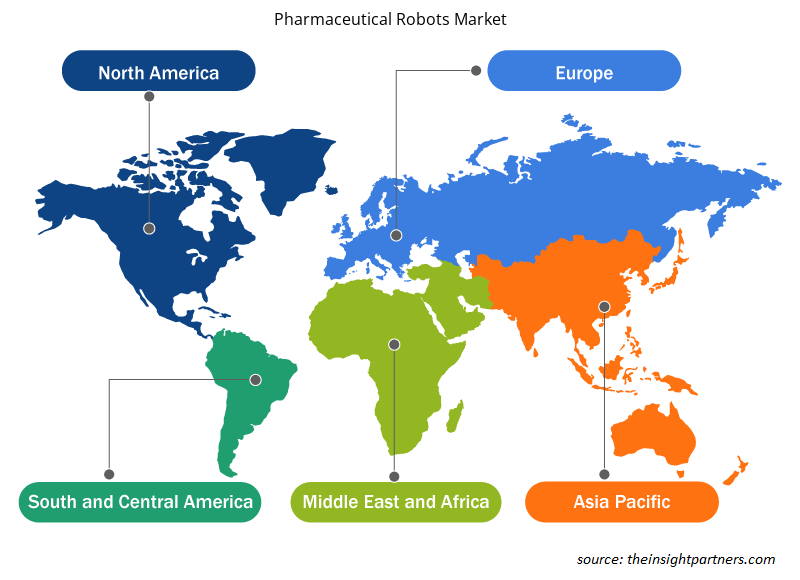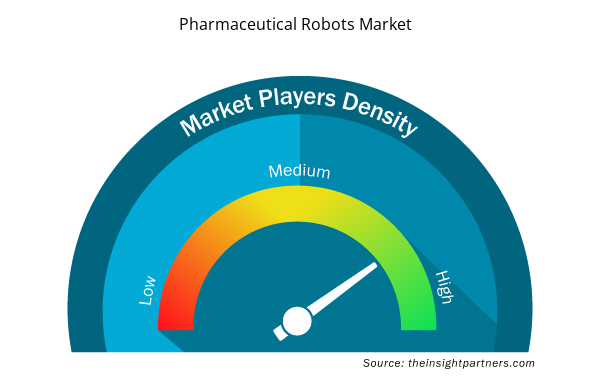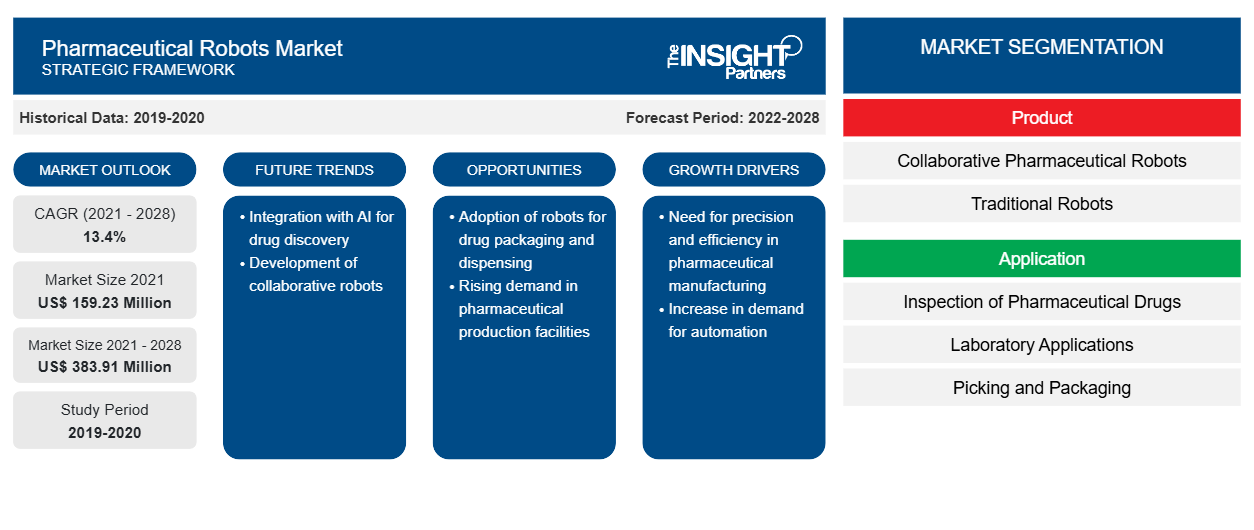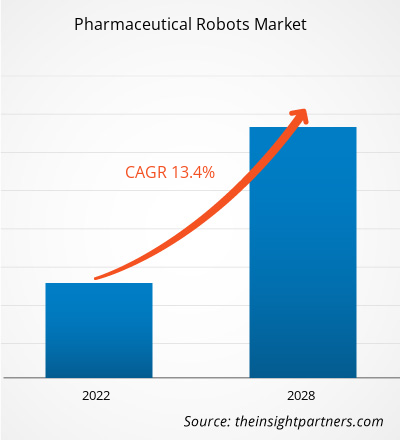[Forschungsbericht] Der Markt für Pharmaroboter soll von 159,23 Millionen US-Dollar im Jahr 2021 auf 383,91 Millionen US-Dollar im Jahr 2028 anwachsen; von 2021 bis 2028 wird ein durchschnittliches jährliches Wachstum von 13,4 % erwartet.
Die Pharmaindustrie erfordert eine effiziente und präzise Produktion von Arzneimitteln. Der Einsatz von Robotern in der Arzneimittelherstellung verbessert daher die Qualität und reduziert Kosten und Zeit. Roboter erweisen sich beim Abfüllen, Prüfen, Verpacken, in Laboren und bei der Herstellung personalisierter Medikamente als vorteilhaft. Ein Robotersystem ist eine Art Automatisierung, die über mehrere Bewegungsachsen verfügt und für die Ausführung beliebiger Funktionen programmiert werden kann.
Der Bericht bietet Einblicke und eine eingehende Analyse des Marktes für pharmazeutische Roboter und legt dabei den Schwerpunkt auf verschiedene Parameter wie Markttrends, technologische Fortschritte, Marktdynamik und Wettbewerbslandschaftsanalysen führender Marktteilnehmer auf der ganzen Welt. Er umfasst auch die Auswirkungen der COVID-19-Pandemie auf den Markt in allen Regionen. Die Auswirkungen der Pandemie und die abnehmenden globalen Forschungsaktivitäten haben auch den Betrieb und die finanzielle Abwicklung mehrerer Unternehmen auf dem Markt für pharmazeutische Roboter beeinträchtigt. Die OIE, die Weltorganisation für Tiergesundheit, unterstützt die Forschung bei ihren laufenden Forschungen und anderen Auswirkungen von COVID-19 auf die Tiergesundheit und die öffentliche Gesundheit von Geflügel. Die Organisation hilft auch bei der Risikobewertung, dem Risikomanagement und der Risikokommunikation. Die OIE hat ein Vorfallkoordinationssystem eingerichtet, um diese Aktivitäten zu koordinieren. Darüber hinaus haben die COVID-19-Pandemie und die daraus resultierenden Lockdown-Auflagen die Vieh- und Geflügelsektoren in verschiedenen Ländern der Welt erheblich beeinträchtigt. Die Lücke zwischen Angebot und Nachfrage verringert sich allmählich mit der Öffnung der Marktketten und zusätzlichen Schritten der lokalen Verwaltungen zur Beseitigung der Engpässe in den Liefersystemen. Es wird außerdem erwartet, dass die Auswirkungen noch lange anhalten und große Auswirkungen auf den Lebensunterhalt, die Beschäftigung und die Gesamtwirtschaft des Sektors haben werden. Der Markt für pharmazeutische Roboter ist nach Dosierung, Krankheit, Technologie und Region segmentiert. Der Markt ist nach Regionen segmentiert in Nordamerika, Europa, Asien-Pazifik, Naher Osten und Afrika sowie Süd- und Mittelamerika.
Markteinblicke
Passen Sie diesen Bericht Ihren Anforderungen an
Sie erhalten kostenlos individuelle Anpassungen an jedem Bericht, einschließlich Teilen dieses Berichts oder einer Analyse auf Länderebene, eines Excel-Datenpakets sowie tolle Angebote und Rabatte für Start-ups und Universitäten.
- Holen Sie sich die wichtigsten Markttrends aus diesem Bericht.Dieses KOSTENLOSE Beispiel umfasst eine Datenanalyse von Markttrends bis hin zu Schätzungen und Prognosen.
Steigender Trend bei Cloud Robotic
Cloud-Robotik ist ein aufstrebendes Feld der Robotik, das auf Cloud-Computing, Cloud-Speicherung und anderen Internet-Technologien basiert und sich auf die Vorteile konvergenter Infrastruktur und gemeinsam genutzter Dienste konzentriert. Die Verbindung von Robotern mit der Cloud erhöht die Rechenleistung, den Speicher und die Kommunikation. Cloud-Roboter kommunizieren miteinander und so können Operationen problemlos durchgeführt werden.
Die Google Cloud Robotics Platform kombiniert KI, Robotik und die Cloud, um die Öffnung eines Ökosystems von Automatisierungslösungen zu ermöglichen, die mit der Cloud verbundene kollaborative Roboter nutzen. Zusammen mit KI- und maschinellen Lerndiensten können die Roboter Prozesse in hochdynamischen Umgebungen in der Fertigungsindustrie effizient ausführen. Darüber hinaus ist die Cloud in der Branche ein Verbündeter bei der Verarbeitung großer Datenmengen. So kündigten Exscientia und Celgene, ein biopharmazeutisches Unternehmen, 2019 einen 19,64-Millionen-Euro-Deal an, um die Entdeckung von Medikamenten gegen Krebs und Autoimmunerkrankungen zu beschleunigen. Im Jahr 2020 kündigte das Unternehmen außerdem eine Zusammenarbeit mit anderen Unternehmen an, um mögliche COVID-19-Medikamente zu finden. Dadurch hat das Unternehmen nun Zugriff auf ein Paket von Molekülen, darunter Medikamente und andere Chemikalien, die erfolgreich am Menschen getestet wurden. Das Unternehmen beabsichtigte, die Liste nach Medikamenten zu durchsuchen, die das Virus bekämpfen könnten. Die Technologie von Exscientia durchsucht die großen Datenbanken und kann genau vorhersagen, welche Verbindungen keine Nebenwirkungen erzeugen, um das gewünschte Ziel zu erreichen. Ähnlich verhält es sich mit einem anderen Pharmaunternehmen, Boehringer Ingelheim, das 2020 mit dem Biotech-Unternehmen Click Therapeutics eine Partnerschaft einging, um digitale Behandlungen im Wert von 500 Millionen Dollar zu entwickeln. Genauer gesagt planten beide Unternehmen eine Zusammenarbeit bei der Entwicklung und dem Vertrieb einer mobilen Anwendung, die Schizophreniepatienten mit kognitiven Defiziten helfen soll. Außerdem hat IBM RoboRXN gegründet, ein Chemielabor, das KI, Cloud Computing und Robotik nutzt, um Medikamente von zu Hause aus zu entwickeln.
Cloudbasierte Software mit entsprechenden Sicherheitsprotokollen kann zur Erleichterung der Integration und Automatisierung eingesetzt werden. Ihr Einsatz trägt dazu bei, den Papierkram der Unternehmen zu reduzieren und die Daten handhabbarer zu machen. Daher wird erwartet, dass Cloud-Robotik in Zukunft der Trend auf dem Markt für pharmazeutische Roboter wird.
Produktbasierte Erkenntnisse
Basierend auf dem Produkt ist der Markt für Pharmaroboter in kollaborative Pharmaroboter und traditionelle Roboter unterteilt. Im Jahr 2021 wird das Segment der kollaborativen Pharmaroboter voraussichtlich den größten Marktanteil haben, während für traditionelle Roboter im Prognosezeitraum die höchste durchschnittliche jährliche Wachstumsrate auf dem Markt erwartet wird. Das Wachstum dieses Segments ist auf den zunehmenden Einsatz von Robotern bei der Abgabe, Sortierung, Kit-Montage und leichten Maschinenbedienung sowie bei traditionelleren Anwendungen im Zusammenhang mit Verpackung und anderen zurückzuführen.
Anwendungsbasierte Erkenntnisse
Basierend auf der Anwendung ist der Markt für Pharmaroboter in die Bereiche Arzneimittelinspektion, Laboranwendungen sowie Kommissionierung und Verpackung unterteilt. Das Segment Arzneimittelinspektion wird 2021 den größten Marktanteil haben und im Prognosezeitraum voraussichtlich die höchste durchschnittliche jährliche Wachstumsrate (CAGR) auf dem Markt verzeichnen.
Endbenutzerbasierte Erkenntnisse
Basierend auf dem Endverbraucher ist der Markt für pharmazeutische Roboter in Pharmaunternehmen, Forschungslabore und Auftragsforschungsinstitute unterteilt. Das Segment der Pharmaunternehmen würde im Jahr 2021 den größten Marktanteil halten, während das Segment der Forschungslabore im Prognosezeitraum voraussichtlich die höchste durchschnittliche jährliche Wachstumsrate (CAGR) auf dem Markt verzeichnen wird.
Die Akteure auf dem Markt für Pharmaroboter verfolgen organische Strategien wie Produkteinführung und -erweiterung, um ihre Präsenz und ihr Produktportfolio weltweit zu erweitern und die wachsende Nachfrage zu decken.
Regionale Einblicke in den Markt für pharmazeutische Roboter
Die regionalen Trends und Faktoren, die den Markt für Pharmaroboter im Prognosezeitraum beeinflussen, wurden von den Analysten von Insight Partners ausführlich erläutert. In diesem Abschnitt werden auch die Marktsegmente und die Geografie für Pharmaroboter in Nordamerika, Europa, im asiatisch-pazifischen Raum, im Nahen Osten und Afrika sowie in Süd- und Mittelamerika erörtert.

- Erhalten Sie regionale Daten zum Markt für pharmazeutische Roboter
Umfang des Marktberichts über pharmazeutische Roboter
| Berichtsattribut | Details |
|---|---|
| Marktgröße im Jahr 2021 | 159,23 Millionen US-Dollar |
| Marktgröße bis 2028 | 383,91 Millionen US-Dollar |
| Globale CAGR (2021 - 2028) | 13,4 % |
| Historische Daten | 2019-2020 |
| Prognosezeitraum | 2022–2028 |
| Abgedeckte Segmente | Nach Produkt
|
| Abgedeckte Regionen und Länder | Nordamerika
|
| Marktführer und wichtige Unternehmensprofile |
|
Marktdichte von Pharmarobotern: Auswirkungen auf die Geschäftsdynamik verstehen
Der Markt für Pharmaroboter wächst rasant, angetrieben durch die steigende Nachfrage der Endnutzer aufgrund von Faktoren wie sich entwickelnden Verbraucherpräferenzen, technologischen Fortschritten und einem größeren Bewusstsein für die Vorteile des Produkts. Mit steigender Nachfrage erweitern Unternehmen ihr Angebot, entwickeln Innovationen, um die Bedürfnisse der Verbraucher zu erfüllen, und nutzen neue Trends, was das Marktwachstum weiter ankurbelt.
Die Marktteilnehmerdichte bezieht sich auf die Verteilung der Firmen oder Unternehmen, die in einem bestimmten Markt oder einer bestimmten Branche tätig sind. Sie gibt an, wie viele Wettbewerber (Marktteilnehmer) in einem bestimmten Marktraum im Verhältnis zu seiner Größe oder seinem gesamten Marktwert präsent sind.
Die wichtigsten auf dem Markt für pharmazeutische Roboter tätigen Unternehmen sind:
- ABB Ltd.
- Kawasaki Heavy Industries, Ltd.
- Yaskawa Electric Corporation
- Universal Robots A/S
- Marchesini Gruppe SpA
Haftungsausschluss : Die oben aufgeführten Unternehmen sind nicht in einer bestimmten Reihenfolge aufgeführt.

- Überblick über die wichtigsten Akteure auf dem Markt für pharmazeutische Roboter
Nach Produkt
- Kollaborative Pharmaroboter
- Traditionelle Roboter
- Delta Roboter
- Gelenkroboter
- Kartesische Roboter
- SCARA Roboter
- Sonstiges
Nach Anwendung
- Inspektion von Arzneimitteln
- Laboranwendungen
- Kommissionierung und Verpackung
Nach Endbenutzer
- Pharmaunternehmen
- Forschungslabore
- Auftragsforschungsinstitute
Von
Geographie
Nordamerika
- UNS
- Kanada
- Mexiko
Europa
- Frankreich
- Deutschland
- Italien
- Vereinigtes Königreich
- Spanien
- Restliches Europa
Asien-Pazifik (APAC)
- China
- Indien
- Südkorea
- Japan
- Australien
- Restlicher Asien-Pazifik-Raum
Naher Osten und Afrika (MEA)
- Südafrika
- Saudi-Arabien
- Vereinigte Arabische Emirate
- Rest von MEA
Süd- und Mittelamerika (SCAM)
- Brasilien
- Argentinien
- Rest von SCAM
Firmenprofile
- ABB Ltd.
- Kawasaki Heavy Industries, Ltd.
- Yaskawa Electric Corporation
- Universal Robots A/S
- Marchesini Gruppe SpA
- Denso Corporation
- Fanuc Corporation
- Espon India Pvt. Ltd.
- Shibuya-Unternehmen
- Weiss GmbH
- Historische Analyse (2 Jahre), Basisjahr, Prognose (7 Jahre) mit CAGR
- PEST- und SWOT-Analyse
- Marktgröße Wert/Volumen – Global, Regional, Land
- Branche und Wettbewerbsumfeld
- Excel-Datensatz



Report Coverage
Revenue forecast, Company Analysis, Industry landscape, Growth factors, and Trends

Segment Covered
This text is related
to segments covered.

Regional Scope
North America, Europe, Asia Pacific, Middle East & Africa, South & Central America

Country Scope
This text is related
to country scope.
Häufig gestellte Fragen
The growth of the market is attributed to benefits offered by robots in pharmaceutical manufacturing, growing awareness of robotic systems in manufacturing process, increasing investments in pharmaceutical research and development. However, the high cost of robots and dearth of skilled professional hinder the market growth.
The types of pharmaceutical robots are collaborative pharmaceutical robots, and traditional robots. The traditional robots are segmented into delta robots, articulated robots, cartesian robots, scara robots, and others.
Pharmaceutical industry requires efficient and precise precision in production of pharmaceutical drugs. Thus, using robots in pharmaceutical manufacturing improves quality and reduces cost and time. Robots are proving advantageous in filling, inspection, packaging, laboratories, and the manufacture of personalized medicine. A robotic system is a type of automation that has multiple axes of motion and can be programmed to perform any function.Pharmaceutical industry requires efficient and precise precision in production of pharmaceutical drugs. Thus, using robots in pharmaceutical manufacturing improves quality and reduces cost and time. Robots are proving advantageous in filling, inspection, packaging, laboratories, and the manufacture of personalized medicine. A robotic system is a type of automation that has multiple axes of motion and can be programmed to perform any function.
Trends and growth analysis reports related to Life Sciences : READ MORE..
The List of Companies - Pharmaceutical Robots Market
- ABB Ltd.
- Kawasaki Heavy Industries, Ltd.
- Yaskawa Electric Corporation
- Universal Robots A/S
- Marchesini Group S.p.A
- Denso Corporation
- Fanuc Corporation
- Espon India Pvt. Ltd.
- Shibuya Corporation
- Weiss GmbH
The Insight Partners performs research in 4 major stages: Data Collection & Secondary Research, Primary Research, Data Analysis and Data Triangulation & Final Review.
- Data Collection and Secondary Research:
As a market research and consulting firm operating from a decade, we have published and advised several client across the globe. First step for any study will start with an assessment of currently available data and insights from existing reports. Further, historical and current market information is collected from Investor Presentations, Annual Reports, SEC Filings, etc., and other information related to company’s performance and market positioning are gathered from Paid Databases (Factiva, Hoovers, and Reuters) and various other publications available in public domain.
Several associations trade associates, technical forums, institutes, societies and organization are accessed to gain technical as well as market related insights through their publications such as research papers, blogs and press releases related to the studies are referred to get cues about the market. Further, white papers, journals, magazines, and other news articles published in last 3 years are scrutinized and analyzed to understand the current market trends.
- Primary Research:
The primarily interview analysis comprise of data obtained from industry participants interview and answers to survey questions gathered by in-house primary team.
For primary research, interviews are conducted with industry experts/CEOs/Marketing Managers/VPs/Subject Matter Experts from both demand and supply side to get a 360-degree view of the market. The primary team conducts several interviews based on the complexity of the markets to understand the various market trends and dynamics which makes research more credible and precise.
A typical research interview fulfils the following functions:
- Provides first-hand information on the market size, market trends, growth trends, competitive landscape, and outlook
- Validates and strengthens in-house secondary research findings
- Develops the analysis team’s expertise and market understanding
Primary research involves email interactions and telephone interviews for each market, category, segment, and sub-segment across geographies. The participants who typically take part in such a process include, but are not limited to:
- Industry participants: VPs, business development managers, market intelligence managers and national sales managers
- Outside experts: Valuation experts, research analysts and key opinion leaders specializing in the electronics and semiconductor industry.
Below is the breakup of our primary respondents by company, designation, and region:

Once we receive the confirmation from primary research sources or primary respondents, we finalize the base year market estimation and forecast the data as per the macroeconomic and microeconomic factors assessed during data collection.
- Data Analysis:
Once data is validated through both secondary as well as primary respondents, we finalize the market estimations by hypothesis formulation and factor analysis at regional and country level.
- Macro-Economic Factor Analysis:
We analyse macroeconomic indicators such the gross domestic product (GDP), increase in the demand for goods and services across industries, technological advancement, regional economic growth, governmental policies, the influence of COVID-19, PEST analysis, and other aspects. This analysis aids in setting benchmarks for various nations/regions and approximating market splits. Additionally, the general trend of the aforementioned components aid in determining the market's development possibilities.
- Country Level Data:
Various factors that are especially aligned to the country are taken into account to determine the market size for a certain area and country, including the presence of vendors, such as headquarters and offices, the country's GDP, demand patterns, and industry growth. To comprehend the market dynamics for the nation, a number of growth variables, inhibitors, application areas, and current market trends are researched. The aforementioned elements aid in determining the country's overall market's growth potential.
- Company Profile:
The “Table of Contents” is formulated by listing and analyzing more than 25 - 30 companies operating in the market ecosystem across geographies. However, we profile only 10 companies as a standard practice in our syndicate reports. These 10 companies comprise leading, emerging, and regional players. Nonetheless, our analysis is not restricted to the 10 listed companies, we also analyze other companies present in the market to develop a holistic view and understand the prevailing trends. The “Company Profiles” section in the report covers key facts, business description, products & services, financial information, SWOT analysis, and key developments. The financial information presented is extracted from the annual reports and official documents of the publicly listed companies. Upon collecting the information for the sections of respective companies, we verify them via various primary sources and then compile the data in respective company profiles. The company level information helps us in deriving the base number as well as in forecasting the market size.
- Developing Base Number:
Aggregation of sales statistics (2020-2022) and macro-economic factor, and other secondary and primary research insights are utilized to arrive at base number and related market shares for 2022. The data gaps are identified in this step and relevant market data is analyzed, collected from paid primary interviews or databases. On finalizing the base year market size, forecasts are developed on the basis of macro-economic, industry and market growth factors and company level analysis.
- Data Triangulation and Final Review:
The market findings and base year market size calculations are validated from supply as well as demand side. Demand side validations are based on macro-economic factor analysis and benchmarks for respective regions and countries. In case of supply side validations, revenues of major companies are estimated (in case not available) based on industry benchmark, approximate number of employees, product portfolio, and primary interviews revenues are gathered. Further revenue from target product/service segment is assessed to avoid overshooting of market statistics. In case of heavy deviations between supply and demand side values, all thes steps are repeated to achieve synchronization.
We follow an iterative model, wherein we share our research findings with Subject Matter Experts (SME’s) and Key Opinion Leaders (KOLs) until consensus view of the market is not formulated – this model negates any drastic deviation in the opinions of experts. Only validated and universally acceptable research findings are quoted in our reports.
We have important check points that we use to validate our research findings – which we call – data triangulation, where we validate the information, we generate from secondary sources with primary interviews and then we re-validate with our internal data bases and Subject matter experts. This comprehensive model enables us to deliver high quality, reliable data in shortest possible time.


 Holen Sie sich ein kostenloses Muster für diesen Bericht
Holen Sie sich ein kostenloses Muster für diesen Bericht